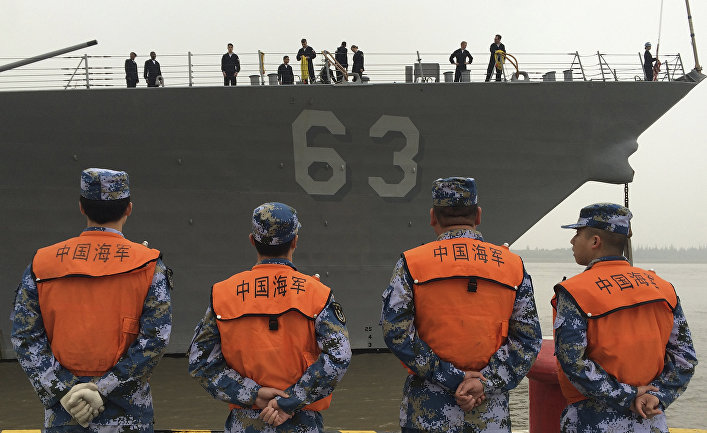According to reports by China's CCTV, on January 5 the US Navy issued a communiqué, claiming that after the end of the Cold War, the US Navy has faced no rivals at sea. Yet China's rising military might, alongside Russia's, now means that America's navy now faces a foe for the first time in 25 years.
How strong is the American fleet?
The communiqué is titled “The Plan To Secure the USA's Dominant Position At Sea.” The document analyses the prevailing position which the USA's military fleet occupies, and the main issues – along with an action-plan list which the USA intends to follow through in the upcoming four years to tackle these issues.
It's a matter of fact that despite frequent threats and challenges, the US Navy remains indisputably the world's most powerful maritime force. More crucially, the technological research and development of America's armed services never ceases. In December 2015 alone, the new Zumwalt-class of stealth destroyers underwent their first trials – and if all goes as planned, this new range of warship will enter active service as soon as 2016. The new Ford class of aircraft-carrier is also scheduled to enter service this year, and by 2019 will be in battle-readiness.
Shrinking US Pacific Fleet faces emboldened China: Navy has 182 vessels available to face 300 sailing under Ch… https://t.co/9ANIQGTUTv
— TOI Israel Region (@TOIIsraelRegion) January 5, 2016
Military expert Yin Zhuo has emphasized that the primary level of US naval superiority lies “in its information technology advancement” — holding prime position in areas such as electronic warfare and allies technologies. All of the combat systems are connected into one network, which offers significant gains in combat capability. Alongside this, the US Navy is in poll position for innovation — 'a generation ahead' of the military capabilities of other nations.
What pressure does the US Navy exert on China and Russia?
The most recent report states that the US Navy's foes are China and Russia – and that these two nations continue to develop their arms industries, including weapons specifically aimed at hitting Chinese in US war systems. Cuts in US expenditure will leave the US Navy faced with difficulties – they will not be able to buy their way out of shortcomings by simply in-buying weaponry. On the question of the developments in China's navy, the US military is clearly fixated on keeping pace with the huge leaps forward China has been making in both quantity and quality in recent years.

When it comes to numbers, the Chinese government report “On Security Strategy in the Asia-Pacific Seas,” China upped its total number of warships in the zone to 303 vessels in 2015. According to the US military, this number of Chinese warships not only exceeds all other Asian countries, but also outstrips the US Navy on numbers. On the same day that the American military issued their report, the Associated Press news agency quoted a military source as saying that with only 272 warships, the USA is lagging behind China.
When it comes to the specifications of these fleets, the USA places the highest priorities on its aircraft-carriers and submarines. The Chinese Ministry of Defense has already announced that the first Chinese-produced aircraft carrier is under current construction at the Dalian shipyards. Chinese officials are keeping details of the country's future plans for aircraft-carrier construction close to their chests. However, the Pentagon is expecting the Chinese fleet to boast a substantial number of such carriers by 2030.
In addition to this assessment, top-level American naval authorities have recently the first Chinese strategic nuclear submarines have completed strategic test operations, confirming that these manuvres constitute the “first nuclear-powered battle-ready formations in China's fleet' in a very real sense. Despite this, their assessment received no official confirmation from China's own Ministry of Defense.
See what the Navy's new strategy is for staying ahead of emerging rivals China and Russia. https://t.co/v3LF8jCvM1 pic.twitter.com/P2nIeLhAKI
— WARRIOR (@Warrior_mag) January 6, 2016
Yin Zhuo has speculated that the US Navy is fear-mongering the threat posed by the Chinese Navy in a bid to secure continued military expenditure (from the US government). Over recent years the Chinese Navy has been closing the military technology gap with the USA. Even so, the US still believes that it can keep control over the maritime areas around China. Of course, the Chinese Navy will wish to strengthen its capacity to protect Chinese national interests.
Yin Zhuo: “The pressure that the Russian Navy exerts on the United States is primarily seen in its nuclear forces – in addition to threat posed by tactical nuclear weapons to US aircraft-carriers and other resources. Russia remains the only nation capable of wiping out the USA with its naval nuclear weapons. The Russian Navy is currently expanding, and in the near future could realign from a coastal-defensive role into distant-water foreign deployments. Without American support, not a single European nation can be compared with the power of the Russian fleet. American military forces are inseparable from Europe – and this means the relocation of the strategic centre of gravity to the East.”






